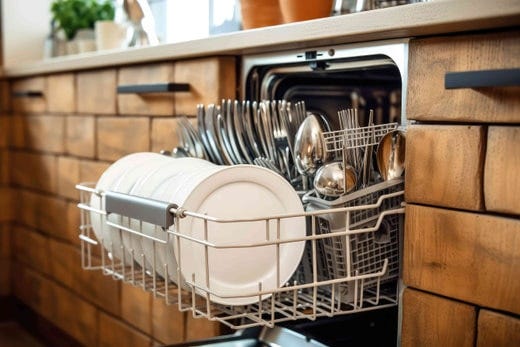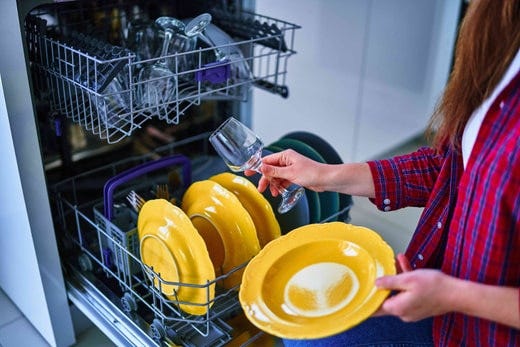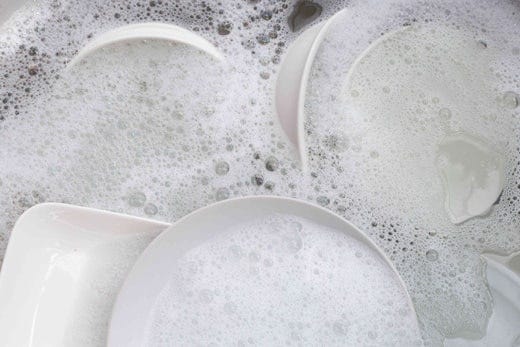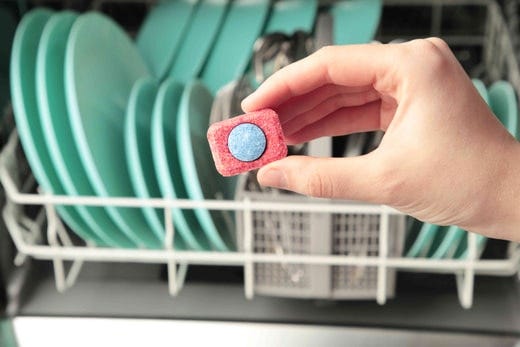
How to Wash Dishes Using a Dishwasher

Dishwashers are invaluable appliances for cleaning dishwashers and cookware. They offer various hygiene benefits and help you save a lot of time, energy, and, ultimately, money.
Since washing dishes is a routine chore in every household, learning how to wash them using a dishwasher and knowing a few essential tips and tricks can lead to cleaner and shinier dishes, leading to a more efficient kitchen environment.
So, embark with us on a journey that will show you how to wash dishes using a dishwasher and maintain optimal cleaning and performance.
1. Load the dishwasher
Don’t rinse the dishes before putting them in the dishwasher. Many people make this mistake!
Ensure there are no big pieces of food remaining on the plates before loading them into the dishwasher to prevent the appliance from clogging.
After that, load the dishes in the dishwasher with even space between them and the dirty side angled down toward the water jets. Don’t overlap your dishes since doing so prevents the water jets from reaching the inside for thorough cleaning.
Top Rack:
- Load items such as bowls, cups, mugs, wine glasses, and water bottles in the upper rack of the dishwasher.
- Arrange small bowls and plates between the tines or prongs on the rack.
- Put plastic containers and their lids exclusively on the top rack to prevent warping. Make sure your plasticware is dishwasher-safe by checking the dishware symbols before loading.
Bottom Rack:
- Load large kitchenware, such as dinner plates, serving platters, dishwasher-safe baking dishes, stainless steel pots, and heavily soiled dishes, into the lower rack of the dishwasher.
- Arrange pots and pans along the sides or towards the back of the dishwasher.
- Place utensils in the dishwasher's utensil basket, ensuring that sharp objects like knives are facing downward to prevent injuries.
- Check for any obstructions that might block the wash arms before closing the dishwasher door.
Some dishwasher models come with a third rack where you can load extra silverware, utensils, and other hard-to-fit items. Read more information on what to load where, and use our guide on how to load your dishwasher properly.
2. Load the dishwasher detergent
Although it depends on the dishwasher's make and model, most of them have dishwasher detergent on the bottom inside the door of the dishwasher. Using our guide to parts of a dishwasher, you can familiarize yourself with the dishwasher detergent dispenser and other crucial parts of the dishwasher.
- Place the dishwasher detergent in the dispenser. Check out our guide about choosing the best dishwasher detergent, as using the right detergent is imperative for achieving spotless, sparkling, and shiny dishes.
- Add Finish rinse aid to the dispenser up to the line that says Full (available on some models). Rinse aids will help prevent water spots on your dishes, ensuring a brilliant shine on your glasses and dishes.
- Close the lid and press firmly until it clicks shut. After the dishwasher completes an initial pre-wash cycle, the lid opens to mix detergent with the water.
Selecting the right dishwasher detergent, whether tablets, liquid, or powder, is important for getting the best cleaning results and optimizing your dishwasher's performance.
Only use detergents, such as Finish dishwasher detergents, that are specifically formulated with enzymes, non-ionic surfactants, and oxygen-based bleaching agents to remove grease, grime, and stains.
3. Select the wash cycle
Dishwashers typically offer three cycles: Quick, Normal, and Heavy Duty. The choice of cycle depends on your load size and dish dirtiness. To select a cycle, use the buttons usually found on the top or front controls of the dishwasher door.
- Quick cycle: Employs increased water, energy, and higher temperatures for swift outcomes, ideal for lightly soiled dishes requiring prompt use.
- Normal cycle: Widely used, tackles daily messes efficiently without excess water usage. It suits regular loads that aren't heavily soiled.
- Heavy Duty Cycle: Best for loads containing heavily soiled items like pots and pans, utilizing extra water and higher temperatures for thorough cleaning of cookware.
Read our article about the standard dishwasher settings and cycles to understand what your machine is capable of and ensure you’re getting the most out of your model.
Additionally, for the best dishwashing performance, the water temperature should be 51-60°C as it enters the dishwasher. Find out everything you need to know about your dishwasher water with Finish’s dishwashing temperature guidelines.
4. Start the dishwasher
Before you choose your cycle, close the dishwasher door and press start. Make sure to confirm that nothing is obstructing the wash arms. Typically, a regular load will be completed in 1.5 to 4 hours, and an indicator light on the front or top of your dishwasher will signal when the cycle has finished.
.png?width=70&height=45&format=png&quality=50)


